The Samsung 850 EVO 4TB SSD Review
by Billy Tallis on July 11, 2016 10:00 AM ESTMixed Random Read/Write Performance
The mixed random I/O benchmark starts with a pure read test and gradually increases the proportion of writes, finishing with pure writes. The queue depth is 3 for the entire test and each subtest lasts for 3 minutes, for a total test duration of 18 minutes. As with the pure random write test, this test is restricted to a 16GB span of the drive, which is empty save for the 16GB test file.
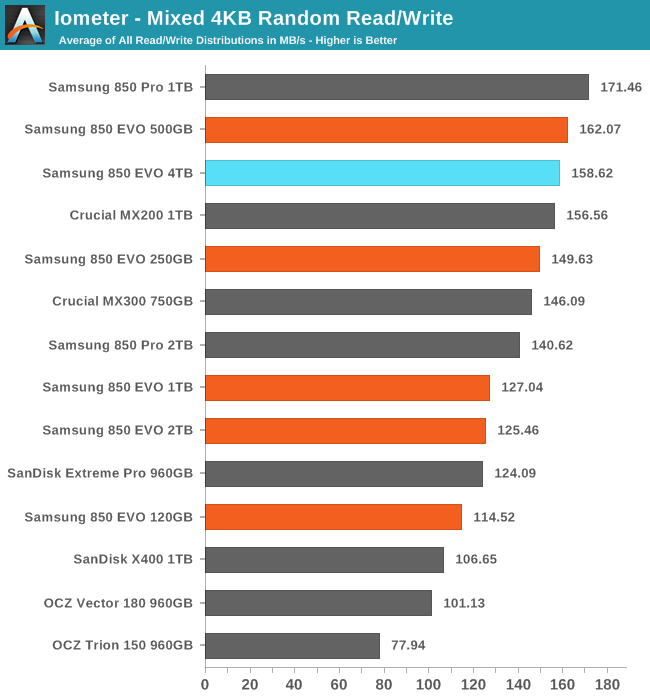
The mixed random I/O performance of the 4TB 850 EVO is much better than the other large 850 EVOs, putting te 4TB model close to the top of the chart.
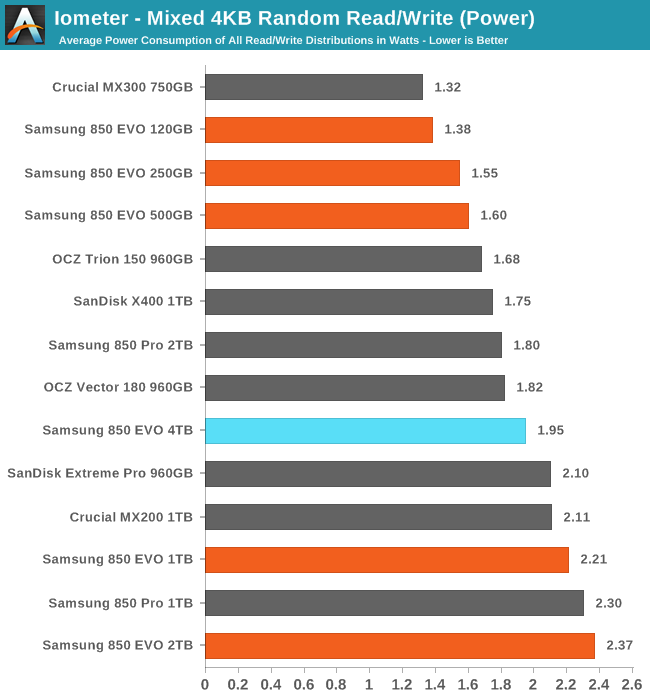
The 4TB 850 EVO also manages a large reduction in power usage as compared with the 1TB and 2TB 850 EVOs, making the 4TB much more efficient.
 |
|||||||||
Unlike the other 850 EVOs, the 4TB never loses performance as the proportion of writes in the test workload increases. Meanwhile, the power draw is essentially constant until near the end of the test.
Mixed Sequential Read/Write Performance
The mixed sequential access test covers the entire span of the drive and uses a queue depth of one. It starts with a pure read test and gradually increases the proportion of writes, finishing with pure writes. Each subtest lasts for 3 minutes, for a total test duration of 18 minutes. The drive is filled before the test starts.
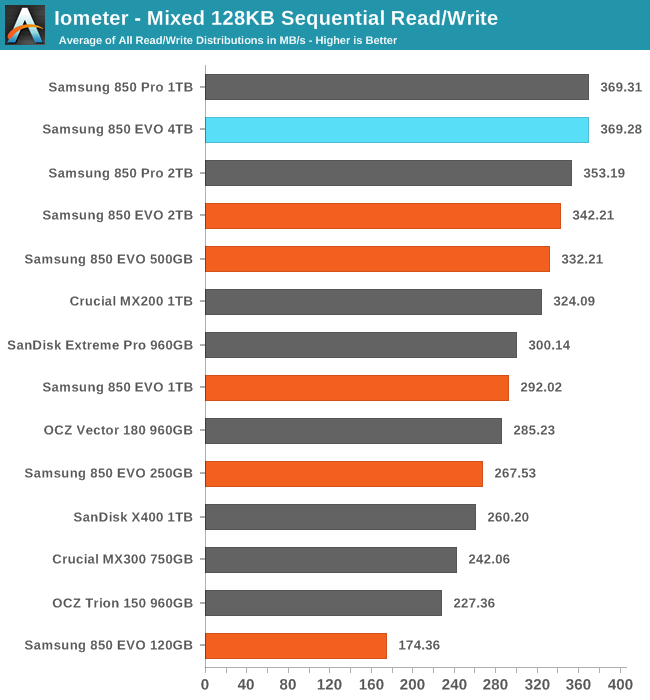
The 4TB 850 EVO is essentially tied for the best mixed sequential read and write performance.
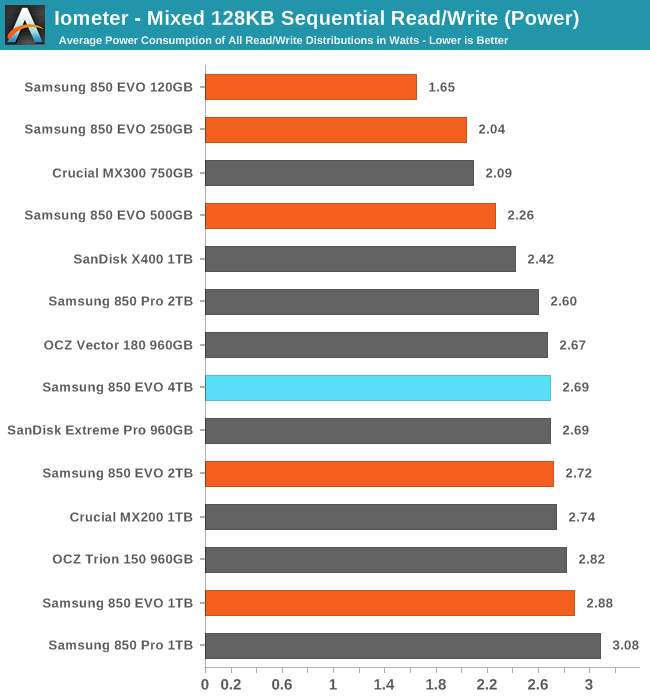
The 4TB 850 EVO averages using slightly less power than the 2TB model, and it is one of the most efficient of the large drives.
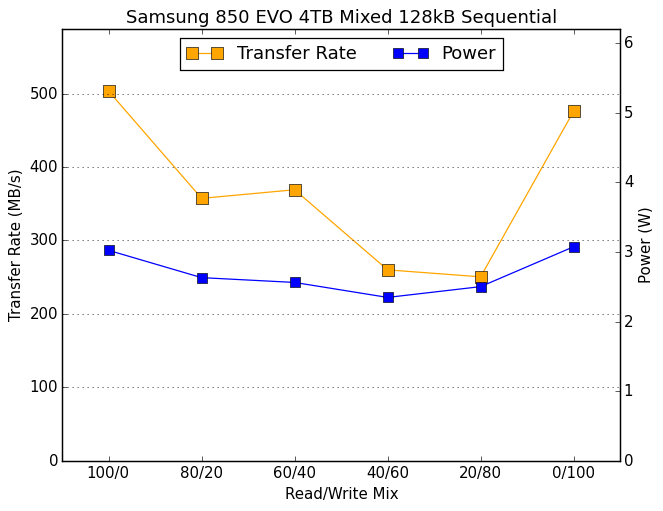 |
|||||||||
The usual pattern is for performance on this test to resemble a bathtub curve, but the 2TB 850s and the 4TB 850 EVO don't lose as much of their performance during the first half of the test, leading them to bottom out much later than most other drives.










145 Comments
View All Comments
nandnandnand - Monday, July 11, 2016 - link
Weren't the first XPoint parts going to be 16-32 GB? I find $0.65/GB hard to believe... I expect $3.00/GB.nathanddrews - Monday, July 11, 2016 - link
Yeah, I'll believe it when I see it.Kevin G - Monday, July 11, 2016 - link
Where are you seeing this and for what format?I strongly suspect that Intel is going to be price competitive in the NVMe space so that's realistic but I'd expect a massive premium for Xpoint in DIMM format when Skylake-E comes around.
shabby - Monday, July 11, 2016 - link
Why would xpoint dimm be premium priced? They said its slower than dimm, so it should be cheaper.Kevin G - Monday, July 11, 2016 - link
Well what competition would the DIMM format have on SkyLake-E?SATA based SSDs are a dime a dozen and M.2 drives using NVMe are just starting to spread. What competition would Intel have with a DIMM format?
Impulses - Monday, July 11, 2016 - link
There's a lot of pie in the sky dreaming about Xpoint IMO... Why would it be priced at a premium? Same reason M.2 NVMe & PCI-E drives are, it's what the market will bear that counts. If it's any faster it'll be more expensive, simple really.ddriver - Monday, July 11, 2016 - link
Don't hold your breath. They made claims of "ram" speed, but demoed 2 GB/s hardware, which is not much faster than nvme SSDs. Ram is 20-30 GB/s...SSDs can still go a long way in terms of bandwidth - just snap more chips on more channels, given an available interface to hook it to, it would be too much trouble for the industry to create something like 8 GB/s SSD. And it only requires a better controller chip, can work with the same old flash memory chips. Currently, M2 can only provide theoretical 4 GB/s bandwidth, running at 32 gbit.
Eden-K121D - Monday, July 11, 2016 - link
a PCIe gen4 device could have potential read speeds of 8GB/sKevin G - Monday, July 11, 2016 - link
The 2 GB/s demo was using a Thunderbolt enclosure and an M.2 prototype.Full size PCIe and DIMM formats are planned so I'd consider that 2 GB demo the starting point.
benedict - Monday, July 11, 2016 - link
Horrible write endurance. If you need a drive that big you certainly have enough data to fill it 75 times.